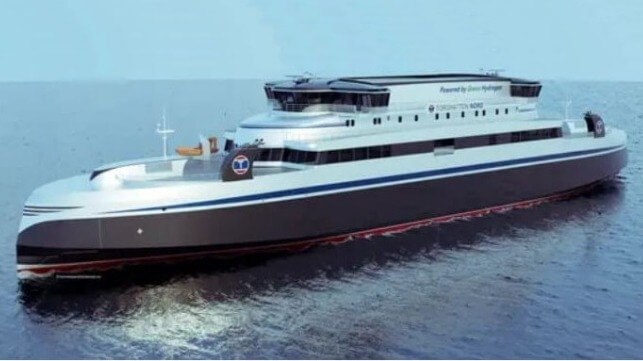The designs have been finalized and the shipyard was chosen for an ambitious project to build two of the world’s largest hydrogen-fueled passenger and car ferries. The project has been in development for several years with the designs initially approved in 2022 and now with the shipyard selected, Norway expects the vessels will be delivered in 2026.

“There are no other maritime hydrogen projects internationally that come close to the scale and ambitions of this project,” says Marius Hansen Managing Director of Norwegian ferry company Torghatten Nord. He recognizes that extensive time was spent developing the designs for the pioneering vessels noting that there has been a strong focus on safety and developing the Norwegian suppliers.
The project selected Myklebust Verft to build the two ferries. They are calling it a big boost for Norwegian technology and the shipyard. The project is expected to set the standard for a new class of ship and continue Norway’s leadership in sustainable shipbuilding.
The two hydrogen fueled RoPax ferries were designed by Norwegian Ship Design. Each vessel will be approximately 380 feet (117 meters) long with a capacity to carry 120 cars and 599 passengers. Norwegian Ship Design says they will operate full time on hydrogen requiring 5 to 6 t of hydrogen each day. They will be bunkered with hydrogen produced in Bodo in northern Norway.
The Norwegian Public Roads Administration awarded a contract to Torghatten Nord in 2022 for the construction and operation of the new ferries after a competitive bidding process which saw at least three companies competing for the pioneering project. Because the vessels will provide an essential commercial service to the residents and local fishing industry, the contract requires that they be dual-fueled, although at least 85 percent of the time they are required to operate on hydrogen. In addition, the contract requires that the hydrogen be produced with low greenhouse gas emissions with the expectation that together they will help to cut 26,500 tonnes of CO2 each year.
“Together with the maritime cluster in Norway, we will develop new knowledge, secure jobs, and be able to take on more apprentices with this assignment,” said Leiv Sindre Muren, CEO of Myklebust Verft. “It will be exciting to deliver something that no one has done before us.”
The vessels are designed to operate the approximately 50 nautical mile run between the Norwegian mainland at Bodo to the Lofoten islands, a popular tourist destination in Norway. Currently, the route is maintained with LNG-fueled ferries that have been in service since 2012. The route requires three to four hours sailing time meaning that vessels will both travel long distances and be exposed to the harsh environment in the northern region.
The project organizers highlight that passenger traffic with hydrogen has not been carried out over such long distances and demanding sea conditions. They are saying that the vessels will be “packed with new technology.”
Torghatten Nord is involved in several pioneering projects including a self-navigating ferry in Stockholm. They are also developing long-distance battery-powered ferries.